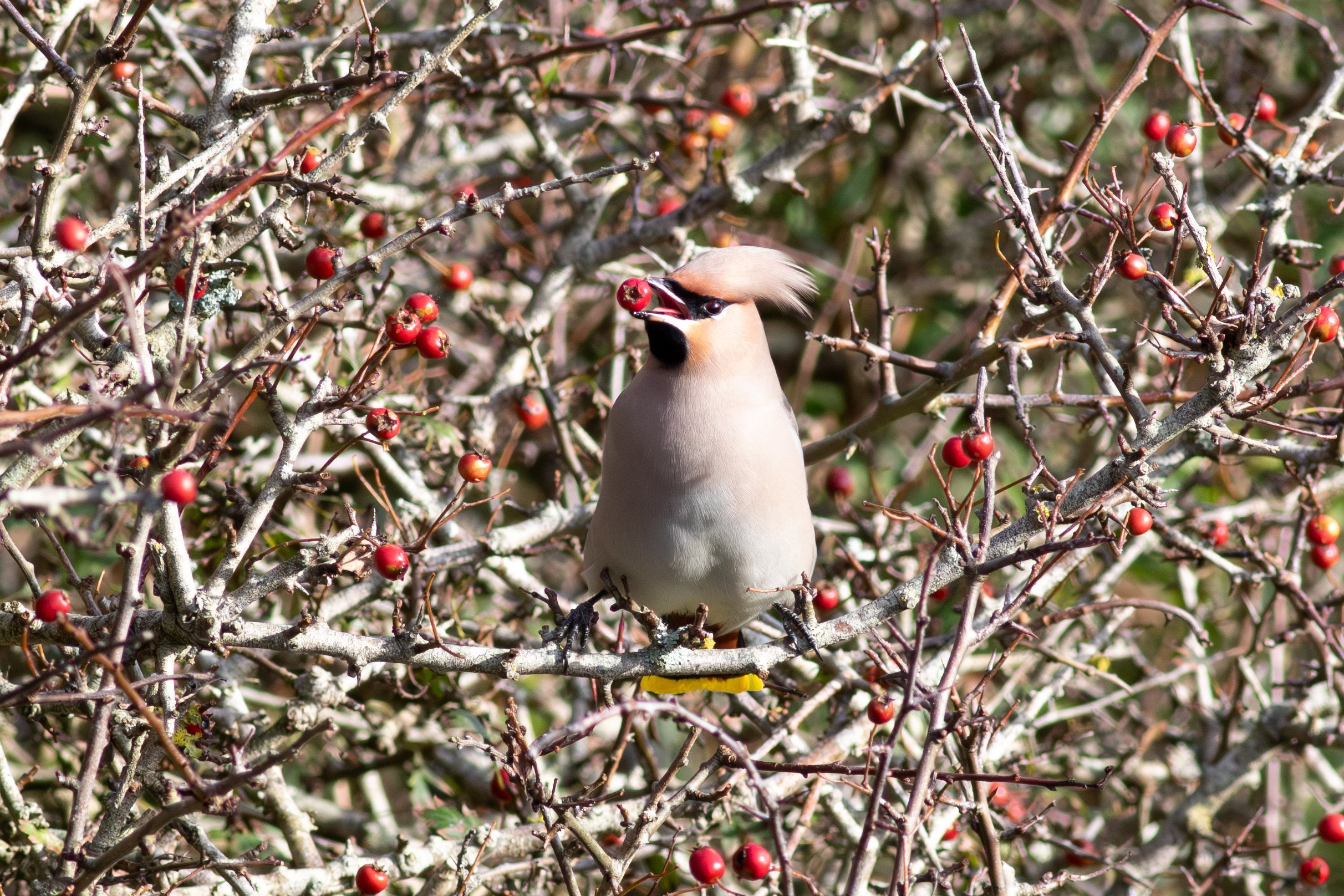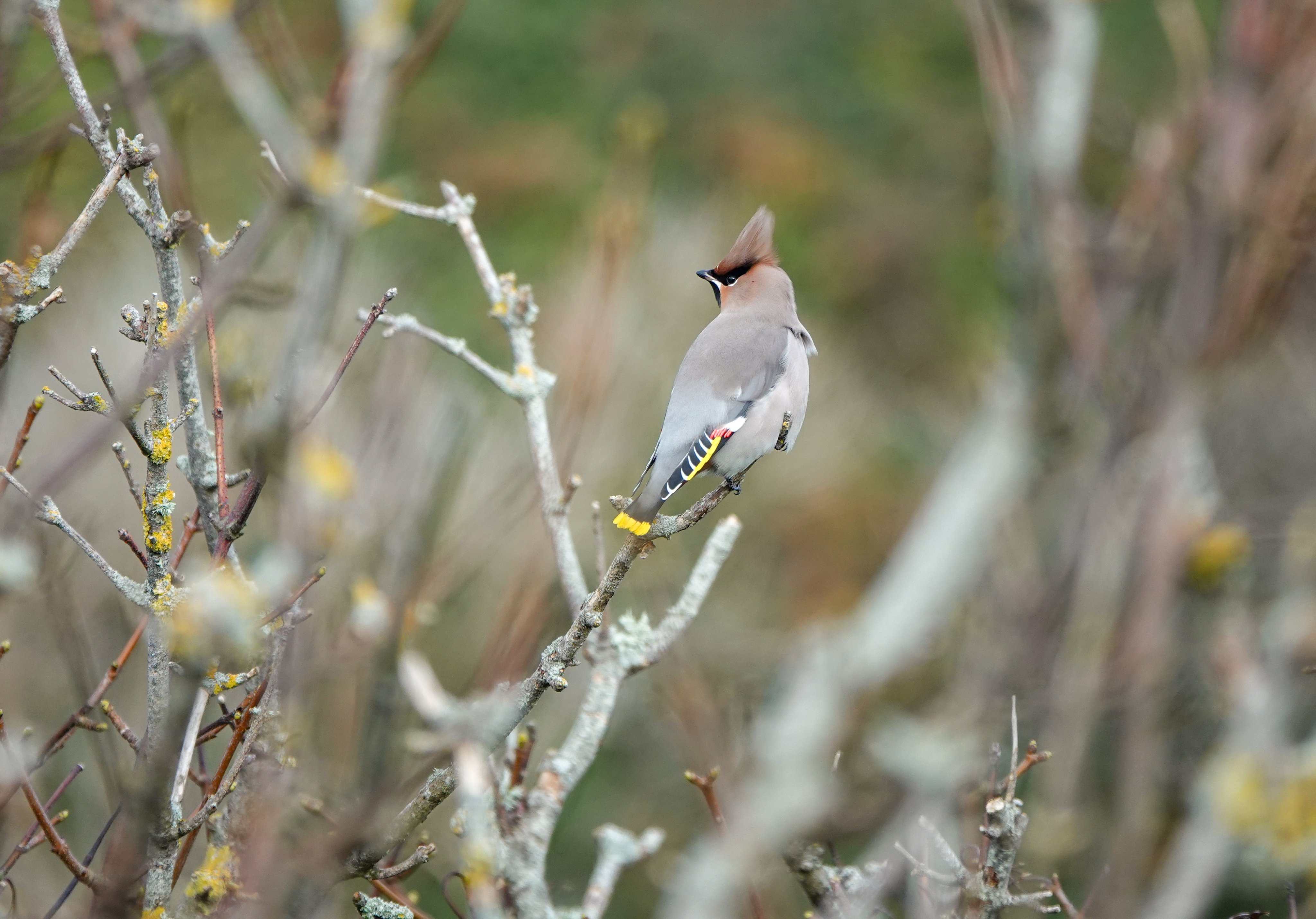Fairly windy and a lot of rainfall throughout this period with very few birds around or moving on some days. A bit of respite on 30th saw a bit more passage before a series of storms blew in from the Atlantic, with named Storm Ciaran arriving in the evening of the 1st November.
After one previous record on 16th November 1956, just the second Lundy record of Surf Scoter was found off of the east coast on the 27th. The female type bird was initially picked beyond Rat Island but obligingly moved closer into the Landing Bay allowing better observation and confirmation of the ID. Unfortunately, a Great Northern Diver resurfaced beside the scoter and spooked it. The Surf Scoter flew straight back out to sea and was not seen again. An adult female Shelduck was present on census on the flooded ground beside the water tanks on the 3rd. Three Teal were seen over the sea from the east coast on the 1st and later sitting in the calm waters of the Landing Bay. By the 2nd they had joined our single bird up at Pondsbury, and on the 3rd another two birds had joined the flock making a total of six.
 |
| Record shot of female type Surf Scoter in Landing Bay © Andy Jayne |
 |
| Adult female Shelduck near to the Water Tanks © Angus Croudace |
A check of Brazen Ward on the 28th found a flock of 32 Oystercatcher which is the highest count since spring. A single Golden Plover overflew the airfield on 30th and was calling high over Millcombe on the 31st, and heard again over the water tanks on the 3rd.
Nocturnal survey effort continues, made somewhat easier by the changing clocks. Another three Woodcock were ringed on the 30th with two other birds seen and another single flushed in daylight on the Lower East Coast Path. Unfortunately one carcass was found in SW field on the 3rd; likely a Peregrine Falcon kill. Three Jack Snipe were found on the 30th with one ringed, and another was found near Quarter Wall in daylight hours on the 31st. The island is holding a large amount of surface water at the moment with plenty of excellent areas for snipe to roost or feed, so they're turning up all over the place, not just in a few key areas that were typically frequented earlier in the autumn. Barton Field has contained a Jack Snipe on every survey since mid October, but now we're encountering them in places such as the airfield too. High counts of six Common Snipe were recorded on the 30th and the 2nd with two separate observations of a bird being pursued by a Peregrine Falcon on the 29th and 30th.
The storms have seen seabirds gathering to feed in weather windows in the lee of the island towards the end of this period, with 500 Kittiwake on the 31st and over 1500 on the 1st November. Over 100 Gannet and 80 auks amongst them. Our long staying winter plumage Great Northern Diver was joined by another which retained much of its glorious summer plumage on the 28th. A third bird was also seen with them on the 30th. At least one has been seen daily since. A single Cormorant flew over the island on the 28th, 31st and 1st. A Grey Heron is still picked up occasionally and up to three Water Rail can still be heard calling in Millcombe Valley.
 |
| Summer Plumage Great Northern Diver in the Landing Bay © Angus Croudace |
Up to seven Chiffchaff are recorded daily, although typically just three in Millcombe and a couple along the east coast. The long staying Yellow-browed Warbler showed very nicely at Quarter Wall on the 27th but has not been seen since. A little more movement on the 30th with 18 Blackcap new in after a couple of blank days in the log book. Similarly for Goldcrest with nine on the 30th and 12 on the 31st. A very showy Firecrest was easily seen and heard from the beach road at Windy Corner on the 29th and 30th, before two were then trapped and ringed on the 31st
 |
| Firecrest, Beach Road © Angus Croudace |
Another influx of at least 100 Starling joined our longer staying birds on the 30th, but had moved on again by the next day. A Ring Ouzel has been recorded everyday except for the 27th, with two males dropping in below the Timekeeper's Hut on the 30th amongst a small flock of Fieldfare. Fieldfare remained in single figures until the 30th when 70 were recorded in a couple of larger flocks. Around 20-30 have stuck around since, with some birds frequenting the Water Tanks and another flock around the top of Millcombe. We had the second highest count of Redwing for the autumn on the 30th at 110 (after 700 on their big arrival day on the 12th October). Half of these birds erupted out of the beer garden shrubbery and left the island shortly after sunrise. After a couple of blank days at the start of this period, we're recording between five to ten Song Thrush daily since the 30th A flock of ten Blackbird was seen along High Street on the 2nd. A Mistle Thrush was rattling about the village on the 30th and 31st. A single Woodpigeon has been seen in Millcombe on the 31st and 3rd, the first record since the 23rd.
Excitingly, an adult male Waxwing was picked up on census on the 28th and is still present, favouring the lower gardens in Millcombe, although it was also photographed by the Timekeeper's Hut above the Terrace. It evaded the mist nets at our first try, but another go on the 31st in calmer weather was successful, making this bird the first Waxwing ever to be ringed on Lundy! It is just the sixth record of this species for Lundy. They are an annual visitor to the UK in winter, but some years an 'irruption' sees a huge influx when food is scarce or the weather is unusually harsh in their preferred wintering grounds. It's looking like a Waxwing winter this year, with huge numbers already seen across the east coast of the UK, with a few odd records of smaller numbers or individuals making it as far west as Lundy or Ireland.
 |
| Waxwing among the limited selection of berries currently on offer in Millcombe © Joe Parker |
 |
| Waxwing in Sycamores above the Battlements © Angus Croudace |
 |
| Waxwing in the hand © Luke Marriner |
A couple of late Swallow with six on the 31st, some of which roosted overnight with three picked up again on the 1st. A single bird was recorded struggling in the gale force winds over the Airfield on the 2nd, and we were pleased to see that it had survived through into the 3rd, flying around the village. The biggest movement of Skylark was a flock of nine on the 30th with a couple of singles otherwise. A big contrast to Skokholm a bit further north who reported several hundred moving through on the 31st! A Woodlark was found sheltering from the 60mph gusts in the heather around Rocket Pole in the morning of the 2nd.
Stonechat numbers have been notably low this week, often in the low single figures. A late Northern Wheatear was in Brick Field on the 30th. Three days in this period have recorded no wagtails of any species, otherwise just a few single Alba/Pied Wagtails recorded with one Grey Wagtail on the 27th.
Chaffinch numbers have been around 225 throughout 27th-31st except for the 29th with 401. This was also likely an undercount as birds were moving in modest numbers but we lacked the coverage to monitor the full extent. Nearby, at Bull Point in excess of 5000 were recorded on the same morning, although we suspect that some showers out to sea to the north of Lundy meant that the birds moved up the Bristol Channel before making the crossing, hence lower numbers over us despite favourable winds. Passage had stopped by the 1st, with just a score or so found feeding on the tracks or in Millcombe. Just four records of Brambling this week, including a female ringed in Millcombe. We noted about 80 Siskin daily until Storm Ciaran after which just single figures were to be found. A small flock of 8 Linnet has been feeding in St Johns Valley this week, with a couple of singles picked up elsewhere. Two Lesser Redpoll on the 27th are currently the last record in the log book, and on the same day three Snow Bunting were seen on the wall around Tibbet's, although sadly have not been resighted.
 |
| Male Brambling in Sycamores above Millcombe Pines © Angus Croudace |
 |
| Female Brambling ringed in Millcombe © Luke Marriner |